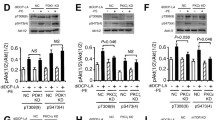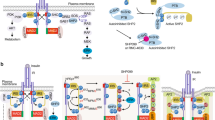Abstract.
In recent years, a number of cross-talk systems have been identified which feed into the insulin signalling cascade at the level of insulin receptor substrate (IRS) tyrosine phosphorylation, e.g., receptor and non-receptor tyrosine kinases and G-protein-coupled receptors. At the molecular level, a number of negative modulator and feedback systems somehow interacting with the β-subunit (catecholamine-, phorbolester-, or tumor necrosis factor-α-induced serine/threonine phosphorylation, carboxy-terminal trimming by a thiol-dependent protease, association of inhibitory/regulatory proteins such as RAD, PC1, PED, α2-HS-glycoprotein) have been identified as candidate mechanisms for the impairment of insulin receptor function by elevations in the activity and/or amount of the corresponding modification enzymes/inhibitors. Both decreased responsiveness and sensitivity of the insulin receptor β-subunit for insulin-induced tyrosine autophosphorylation have been demonstrated in several cellular and animal models of metabolic insulin resistance as well as in the adipose tissue and skeletal muscle of diabetic patients and obese Pima Indians compared to non-obese subjects. Therefore, induction of the insulin signalling cascade by bypassing the defective insulin receptor kinase may be useful for the therapy of non-insulin dependent diabetes mellitus. During the past two decades, phosphoinositolglycans (PIGs) of various origin have been demonstrated to exert potent insulin-mimetic metabolic effects upon incubation with cultured or isolated muscle and adipose cells. However, it remained to be elucidated whether these compounds actually manage to trigger insulin signalling and if so at which level of hierarchy within the signalling cascade the site of interference is located. Recent studies using isolated rat adipocytes and chemically synthesized PIG compounds point to IRS1/3 tyrosine phosphorylation by p59Lyn kinase as the site of cross-talk, the negative regulation of which by interaction with caveolin is apparently abrogated by PIG. This putative mechanism is thus compatible with the recently formulated caveolin signalling hypothesis, the supporting data for which are reviewed here. Though we have not obtained experimental evidence for the involvement of PIG in physiological insulin action, the potential cross-talk between insulin and PIG signalling, including the caveolae/detergent-insoluble glycolipid-enriched rafts as the compartments where the corresponding signalling components are concentrated, thus represent novel targets for signal transduction therapy.
Similar content being viewed by others
Author information
Authors and Affiliations
Additional information
Received 18 May 1999; received after revision 20 July 1999; accepted 8 September 1999
Rights and permissions
About this article
Cite this article
Müller, G., Frick, W. Signalling via caveolin: involvement in the cross-talk between phosphoinositolglycans and insulin. CMLS, Cell. Mol. Life Sci. 56, 945–970 (1999). https://doi.org/10.1007/s000180050485
Issue Date:
DOI: https://doi.org/10.1007/s000180050485




